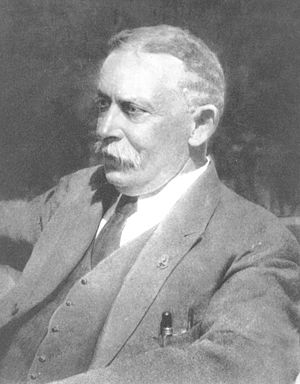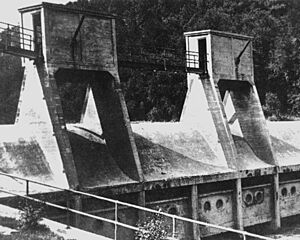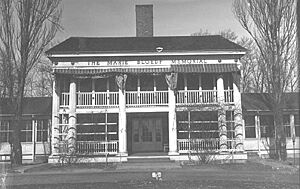Victor Gustav Bloede (chemist) facts for kids
Quick facts for kids
Victor Gustav Bloede I
|
|
|---|---|

Bloede circa 1900
|
|
| Born | March 14, 1849 |
| Died | March 27, 1937 (aged 88) |
| Citizenship | Germany United States |
| Alma mater | Cooper Institute, New York |
| Known for | Entrepreneurship Philanthropist |
| Children | Victor Gustav Bloede II |
| Parent(s) | Marie Franziska Jungnitz Gustav Bloede |
| Relatives | Gertrude Bloede, sister Victor Gustav Bloede III, grandson |
| Awards | Edward Longstreth Medal (1894) |
Victor Gustav Bloede I (born March 14, 1849 – died March 27, 1937), pronounced Blerda, was a talented chemist and a successful businessman. He made chemicals and was the president of the Victor G. Bloede Company.
Contents
Early Life and Education
Victor Bloede was born in 1849 in Dresden, Germany. His parents were Marie Franziska Jungnitz and Gustav Bloede. His father, Gustav, was a doctor and a member of the city council in Dresden. During the German revolutions, Gustav had to leave Germany. He went to Antwerp and waited for his family there.
The family, including Victor, his parents, and his two sisters, Gertrude and Kate, sailed from Antwerp on July 14, 1850. They arrived in New York on August 21. When they came to the United States, Victor's father, Gustav, became a surgeon in the American Civil War. After the war, the family settled in Brooklyn, New York. Their home was a place where many important people, like writer Thomas Bailey Aldrich, would visit.
Victor went to public school for his early education. By the age of 12, he started working to support himself. He worked as an office boy and used his earnings to continue his studies. He studied at night at the Cooper Institute in New York City. There, he was guided by Peter Cooper, a famous industrialist and inventor.
Victor's mother, Marie Bloede, was a big inspiration for him. She encouraged and supported his growth. His family was very cultured; his father was known for his work in science, and two of his mother's uncles were important in literature and politics. Victor also became interested in natural science while studying at the Cooper Institute. He graduated in 1867 with a degree in engineering when he was 18. He was also lucky to know Peter Cooper personally, whose example greatly influenced Victor's life and work.
Career and Innovations
In 1868, Victor Bloede started working at a small chemical company in Brooklyn, New York. This company was located near the Gowanus creek canal. Here, he began to learn about making chemicals and medicines. In 1873, Bloede moved to Pomeroy, Ohio, a place known for making salt.
He joined the Oakes & Rathbone Company in Parkersburg, West Virginia. This company made sulfuric acid for bromine distilleries in the area. The factory was on the south side of the Little Kanawha River. In 1875, Oakes left the company, and Bloede took over his part. The company then became Bloede & Rathbone.
They started making more products, like iron sulfates, iron nitrates, tin salts, and mordants. These chemicals were mostly used by the textile industry. Bloede knew a lot about textiles, which gave him the idea to make aniline dyes to earn more money. At that time, most dyes came from Germany, and only two companies made dyes in the U.S.
Bloede wanted to make aniline by treating benzene with acid to create nitrobenzene, then reducing it. He faced a challenge because he needed to clean the benzene from light tar oils. These oils came in barrels from coal tar distilleries. He didn't have a proper distillation machine, so he used an old boiler connected to a condensing coil. But the benzene he got was not very good.
He then talked to James A. Moffett, an expert in distillation. Moffett worked for the Standard Oil Company in Parkersburg. Moffett believed that making dyes could be very profitable and invested money in Bloede & Rathbone. They created a new company just for making dyes, called American Aniline Works.
The founders of this new company didn't have much experience making dyes. So, they read German books on the subject. They didn't have money for new equipment, so they used old parts from the Standard Oil junk pile. Instead of a heavy cast iron nitrator, they used an old boiler shell that could hold 1,000 gallons. They put a central shaft with iron paddles inside it.
To control the acid flow, an operator used a wire from hundreds of feet away for safety. The operator would quickly run closer to read the temperature and then run back to safety. They cooled the reaction by running cold spring water over the boiler. This process helped them make 7,000 to 8,000 pounds of nitrobenzene in each batch.
In 1883, Bloede started his own business in Baltimore. He was a chemist and made chemical products. He saw many ways to make chemical factories better. He used his skills to greatly improve the chemistry business, especially in how cotton fabrics were dyed. Between 1890 and 1895, he received 15 or 20 patents for his chemical processes. One of his most important patents was for a process to dye "sun-fast" colors that wouldn't fade.
In 1906, Bloede started two new companies: Avalon Water Works and Patapsco Electric & Manufacturing Co. He paid for the building of Bloede's Dam on the Patapsco River. This hydroelectric dam generated power for the Patapsco Electric & Manufacturing Company. This company provided electricity to Catonsville, Maryland and nearby areas. Bloede's Dam was the first hydroelectric dam of its kind in the country.
He also helped start the First National Bank of Catonsville. He was its vice-president for 10 years and became president in 1908. He also planned the Baltimore, Catonsville and Ellicott City Electric railway. In 1910, he helped organize the National City Bank of Baltimore and became one of its directors. His success made him well-known, and he was asked to join many other company boards.
Victor Gustav Bloede died at his home in Catonsville, Maryland.
Helping Others (Philanthropy)
Victor Bloede received many awards for his useful inventions. But he also helped society in many ways. On November 10, 1908, he gave a new building to the Hospital for Consumptives of Maryland. This hospital was a tuberculosis sanitorium.
The hospital, later known as the Eudowood Sanitorium, started in June 1899 on a 23-acre campus in Towson, Maryland. It operated until July 1964. Bloede's building was named the Marie Bloede Memorial Hospital for Advanced Consumptives. It was named in honor of his mother and was one of several buildings at the facility. Important people like the Governor of Maryland, Austin Lane Crothers, and the Mayor of Baltimore, J. Barry Mahool, were there when it was accepted.
Bloede also supported many other good causes and made many improvements in his hometown of Catonsville, Maryland.
Scientific Groups
Victor Bloede was an active member of several scientific groups, including:
- the International Society of Chemical Industry
- the American Chemical Society
- the Chemists' Club of New York City
Inventions and Writings
One of his notable inventions was the adhesive used on postage stamps and envelopes.
He also wrote scientific articles, such as:
- "Some Early Attempts to Establish the Aniline Industry in United States" (1924)
- "The Reducer's Manual and Gold and Silver Worker's Guide" (1867)
Family Life
On June 5, 1883, Victor Bloede married Elise Schon. Elise was the daughter of Carl Schon Sr. from Toledo, Ohio. Carl Schon Sr. designed and built summer homes in Catonsville. He also designed many buildings in Toledo and was in charge of the Toledo waterworks for over 15 years.
Victor and Elise had a happy marriage and five children: Marie, Carl S, Ilse, Victor Gustav Bloede II, and Vida. Victor Bloede was a strong, smart, and forward-thinking person. He believed that physical and mental exercise were important for a healthy body and mind. He often shared his methods for success with others. In his free time, he enjoyed fishing, rowing, and walking. He also liked playing quoits and other games with his family and friends.
He believed that "perseverance" (never giving up) was the secret to success.
One of his sisters, Gertrude Bloede (1845-1905), was a well-known poet. His other two sisters were Kate (1848-1891), who married the artist Abbott Handerson Thayer, and Indiana "Indie" (1854-1936), who married a doctor named Samuel Thomas King.
His grandson was Victor Gustav Bloede III (1920-1999), who became an advertising executive.



